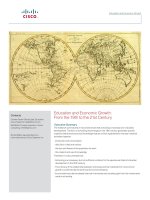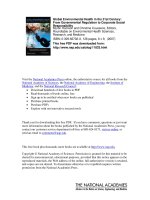lorca-susino - the euro in the 21st century; economic crisis and financial uproar (2010)
Bạn đang xem bản rút gọn của tài liệu. Xem và tải ngay bản đầy đủ của tài liệu tại đây (7.6 MB, 336 trang )
THE EURO IN THE 21ST CENTURY
The International Political Economy of
New Regionalisms Series
The International Political Economy of New Regionalisms series presents
innovative analyses of a range of novel regional relations and institutions. Going
beyond established, formal, interstate economic organizations, this essential series
provides informed interdisciplinary and international research and debate about
myriad heterogeneous intermediate level interactions.
Reective of its cosmopolitan and creative orientation, this series is developed
by an international editorial team of established and emerging scholars in both the
South and North. It reinforces ongoing networks of analysts in both academia and
think-tanks as well as international agencies concerned with micro-, meso- and
macro-level regionalisms.
Editorial Board
Timothy M. Shaw, Institute of International Relations at
The University of the West Indies, St Augustine, Trinidad and Tobago
Isidro Morales, Tecnológico de Monterrey, Escuela de Graduados en
Administracion (EGAP), Mexico
Maria Nzomo, Institute of Diplomacy and International Studies, University
of Nairobi
Nicola Phillips, University of Manchester, UK
Johan Saravanamuttu, Institute of Southeast Asian Studies, Singapore
Fredrik Söderbaum, School of Global Studies, University of Gothenburg, Sweden
and UNU-CRIS, Belgium
Recent titles in the series (continued at the back of the book)
Crafting an African Security Architecture
Addressing Regional Peace and Conict in the 21st Century
Edited by Hany Besada
Comparative Regional Integration
Europe and Beyond
Edited by Finn Laursen
The Rise of China and the Capitalist World Order
Edited by Li Xing
The Euro in the 21st Century
Economic Crisis and Financial Uproar
MARÍA LORCA-SUSINO
University of Miami, USA
© María Lorca-Susino 2010
All rights reserved. No part of this publication may be reproduced, stored in a retrieval system
or transmitted in any form or by any means, electronic, mechanical, photocopying, recording or
otherwise without the prior permission of the publisher.
María Lorca-Susino has asserted her right under the Copyright, Designs and Patents Act, 1988,
to be identied as the author of this work.
Published by
Ashgate Publishing Limited Ashgate Publishing Company
Wey Court East Suite 420
Union Road 101 Cherry Street
Farnham Burlington
Surrey, GU9 7PT VT 05401-4405
England USA
www.ashgate.com
British Library Cataloguing in Publication Data
Lorca-Susino, María.
The euro in the 21st century : economic crisis and
nancial uproar. (The international political economy
of new regionalisms series)
1. Euro. 2. Euro area. 3. European Union countries
Economic integration. 4. European Union countries
Economic conditions 21st century. 5. Financial crises
European Union countries. 6. Board of Governors of the
Federal Reserve System (U.S.) 7. European Central Bank.
8. International Monetary Fund.
I. Title II. Series
332.4'94-dc22
Library of Congress Cataloging-in-Publication Data
Lorca-Susino, María.
The euro in the 21st century : economic crisis and nancial uproar / by María Lorca-Susino.
p. cm. (The international political economy of new regionalisms series)
Includes indexes.
ISBN 978-1-4094-0418-7 (hbk) ISBN 978-1-4094-0419-4 (ebk)
1. Euro. 2. Euro area. 3. European Union countries Economic conditions 21st century.
4. Europe Economic integration. I. Title.
HG925.L67 2010
337.1'42 dc22
2010026844
ISBN 978 1 4094 0418 7 (hbk)
ISBN 978 1 4094 0419 4 (ebk)
I
Contents
List of Graphs vii
List of Tables xi
Foreword xiii
Acknowledgements xvii
List of Abbreviations xix
PART I HISTORICAL AND THEORETICAL INTRODUCTION
TO THE EURO
1 Historical and Theoretical Considerations 3
PART II THE EURO AS A COMMON, INTERNATIONAL, AND
GLOBAL CURRENCY: AN EMPIRICAL STUDY
2 The Euro as a Common Currency 27
3 Statistical Analysis of the Euro as a Stabilizer for the Eurozone 49
4 The Euro as an International and Global Currency 81
PART III THE EURO AND THE EUROZONE: BEFORE,
DURING, AND AFTER THE FIRST ECONOMIC
CRISIS OF THE 21ST CENTURY
5 The New Monetary Order of the 21st Century 111
6 The Eurozone and its First Economic Crisis 143
7 The Future of the Eurozone and the EU at a Crossroads:
Coordination or Breakup 183
8 The Euro in the Twenty-First Century: The Need for a
“Euro Index” 211
The Euro in the 21st Century
vi
PART IV CONCLUSION
9 The Eurozone in the 21st Century 249
Bibliography 275
Index 309
List of Graphs
2.1 European Commission Euro Area Business Climate Indicator 32
2.2 US Conference Board, US Leading Index of 10 Ten Economic
Indicators 33
2.3 GDP based on purchasing power parity (PPP) per capita in
selected AEC countries 37
2.4 Ination in selected AEC countries 37
2.5 GDP based on purchasing power parity (PPP) in Mercosur
full member countries 40
2.6 Ination in Mercosur full member countries 41
2.7 Current account balances in Mercosur full member countries 41
2.8 Alternative measures of political and economic integration—six
countries compared 42
2.9 Economic freedom—six countries compared 43
2.10 Some problematic factors for political integration—six
countries compared 45
3.1 US Dollar Index (USDX) 56
3.2 US Dollar Index with 20-month simple moving average and
de-trended 57
3.3 Deutsche mark composite 57
3.4 Deutsche mark composite and US Dollar Index 58
3.5 Evolution of the euro 59
3.6 Euro and US Dollar Index 59
3.7 Deutsche mark composite and euro 60
3.8 French franc and euro 60
3.9 Spanish peseta and euro 61
3.10 Italian lira and euro 61
3.11 UK pound and euro 62
3.12 Euro and UK pound since 1981 63
3.13 Dow Jones Industrial Average (DJIA) 64
3.14 DJIA with 30-month moving average and de-trended 64
3.15 Deutscher Aktien IndeX 30 (DAX) 65
3.16 DAX with 30-month moving average and de-trended 66
3.17 DJIA and US Dollar Index 66
3.18 DAX and euro 66
3.19 DAX and euro 67
3.20 DJIA and DAX with covariance 67
3.21 DJIA, DAX, and Eurotop 100 68
The Euro in the 21st Century
viii
3.22 Crude Oil and CRB Indexes 69
3.23 CRB and Crude Oil Indexes with covariance 69
3.24 CRB Index and US Dollar Index 70
3.25 Crude Oil and US Dollar Indexes 70
3.26 Crude Oil and US Dollar Indexes with covariance 71
3.27 Crude Oil Index and euro 72
3.28 US 2-year Treasury Note and Eurodollar (3 months) 73
3.29 US 10-year Treasury Note and Bund 74
3.30 Eurodollar (1 month) and Eurodollar (3 months) 74
3.31 EURIBOR (3 months) and Eurodollar (3 months) 75
3.32 EURIBOR (3 months) and LIBOR (1 month) 76
3.33 EURIBOR (3 months) and euro 77
3.34 Euro and Bund 77
4.1 Export activity between Eurozone’s Member States 84
4.2 Total bond issuing activity in Eurozone 86
4.3 Evolution of Eurozone bond issuing—central and local governments 87
4.4 Sovereign bond spread with German yield 89
4.5 Evolution of Eurozone bond issuing—corporate and nancials 90
4.6 GDP comparisons—US, EU, and Eurozone 94
4.7 Comparison of growth in trade exports to the world 95
4.8 Size of the capital market, 2007 97
4.9 Bond, equities, and bank assets compared (as % of GDP), 2007 98
4.10 Financial asset comparison—US and Eurozone 99
4.11 Hourly compensation costs in manufacturing 100
4.12 Labor productivity growth indexes compared 101
4.13 Capacity utilization comparison 102
4.14 Comparison of US and Eurozone GDPs 104
4.15 Consumer Condence Indicators—Eurozone and US compared 105
4.16 Global capital ows 106
5.1 Euro and UK pound, 1981 to 2010 123
5.2 Euro and UK pound, April 2008 to August 2009 125
5.3 Currency reserves worldwide 129
5.4 Special drawing rights, percentage change 130
5.5 Time series data on international reserves and foreign currency
liquidity—selected countries 134
5.6 Bank of Russia foreign exchange reserves by currency 136
5.7 Banco Central do Brasil—reserve currency composition 137
5.8 Chinese yuan and Hong Kong dollar 140
5.9 Euro and the euro/Hong Kong dollar composite 140
5.10 Euro/yuan and euro 140
6.1 Comparative analysis of government debt levels, 2010 145
6.2 Euroarea government debt as % of GDP 146
6.3 Government debt in Eastern EU countries 147
6.4 General government nancial balances—selected countries 149
List of Graphs
ix
6.5 Eurozone government decits 150
6.6 Decits and surpluses in Eastern EU countries 151
6.7 Sovereign bond spread with German yield 152
6.8 The Markit iTraxx Europe Index 154
6.9 EU current account 155
6.10 Current account balances 155
6.11 Economic Sentiment Indicator (ESI) 157
6.12 Recent Spanish economic history 165
6.13 Euro and Crude Oil Index 168
6.14 Spanish peseta and Crude Oil Index 169
6.15 Spanish peseta and DJIA 170
6.16 Credit default swaps 171
6.17 Spanish Tourism Index 173
6.18 Average labor costs per worker in Spain 174
6.19 Spain’s trade balances, 1997–2008 176
6.20 Academic excellence—comparison of Spain with selected countries 177
6.21 Labor productivity index—selected countries 178
6.22 General government debt as % of GDP—Euroarea and Spain 179
6.23 Spain’s total government revenues and expenditures 180
7.1 Trade balances for Germany and the Eurozone 194
8.1 US Dollar Index 214
8.2 Trade-weighted US Dollar Index 216
8.3 US Dollar Index and trade-weighted US Dollar Index 217
8.4 Random walk 219
8.5 White noise 219
8.6 DJIA, DAX, and Eurotop 100 222
8.7 Australian dollar and DJIA 223
8.8 New Zealand dollar and DJIA 223
8.9 Singapore euro and US Dollar Index 224
8.10 US Dollar Index movement—June 2004 to March 2010 225
8.11 A periodic trajectory 228
8.12 Critical point, convergence, and attractor 228
8.13 Sandpile 229
8.14 Critical point in thermodynamics 230
8.15 Fractals: year, month, week, day 231
8.16 Cross-rates used for the Australian Index 234
8.17 Cross-rates for the Australian Index at the critical point 235
8.18 Australian Index and its cross-rates 236
8.19 Cross-rates used for the New Zealand Index 237
8.20 Cross-rates for the New Zealand Index at the critical point 238
8.21 New Zealand Index and its cross-rates 239
8.22 Cross-rates used for the Euro Index 240
8.23 Euro Index and its cross-rates 241
8.24 Self-made US Dollar Index and its cross-rates at the critical point 243
The Euro in the 21st Century
x
8.25 Indexes compared 244
9.1 Job openings and labor turnover survey 252
9.2 Comparison of US and EU productivity 252
9.3 Comparison of US and EU capacity utilization 253
9.4 US Small Business Optimism Index 254
9.5 European Commission Euro Area Business Climate Indicator 255
9.6 Comparison of Consumer Condence Indicators—US Conference
Board and European Commission Consumer Indicator for the
Eurozone 257
9.7 Gross household saving rate—share of gross savings as % of gross
disposable income 258
List of Tables
1.1 Monetary system date overview 7
1.2 Summary of monetary evolution from the Bretton Woods System
to the European Monetary System 9
2.1 List of existing and de facto monetary unions 34
2.2 List of planned monetary unions 35
2.3 Recognized regional economic communities (RECs) 36
3.1 Summary of indexes 50
3.2 Summary of currencies analyzed 51
3.3 Summary of stock exchange, Crude Oil, and CRB Indexes 51
3.4 Summary of money market indexes 52
3.5 Summary of statistical study 52
3.6 Custom-made covariance formula 53
3.7 Custom-made de-trended formula 54
3.8 20-month simple moving average 55
4.1 Functions of an international currency 83
4.2 Some currencies pegged to the US dollar, the euro, the UK
pound, and other currencies 85
4.3 Credit rating of countries by Moody’s, Standard and Poor’s
and Fitch, as at March 7, 2010 88
4.4 Currency Composition of Ofcial Foreign Exchange Reserves
(COFER) (in US$ millions) 91
4.5 Leading exporters and importers in world merchandise trade,
2008 (in € billions) 96
4.6 Financial assets, US and Eurozone compared (in US$ trillions,
using 2008 exchange rates for all years) 97
5.1 Currency distribution of reported foreign exchange market turnover:
percentage share of average daily turnover, April 2007 115
5.2 Daily global foreign exchange turnover, 1989 to 2008
(US$ billions) 115
5.3 Daily average foreign exchange turnover, net of double-counting,
by instrument (US$ millions) 117
5.4 Daily foreign exchange turnover and transactions costs, net of
double-counting, by instrument, counterparty and currency,
April 2004 118
5.5 Daily foreign exchange turnover and transactions costs, net of
double-counting, by instrument, counterparty and currency,
April 2007 120
The Euro in the 21st Century
xii
5.6 Comparative analysis: the UK pound, annual turnover and
transaction costs 121
5.7 Daily averages of trading transactions in the UK pound
(in US$ millions), 2001 and 2007 compared 122
5.8 Special drawing rights allocations to IMF members since 1970 126
5.9 Calculated quota share of SDRs 128
5.10 Participants and credit amounts in IMF’s NAB and CAB
arrangements 132
5.11 Foreign exchange turnover, net of local and cross-border interdealer
double-counting, by instrument, counterparty and currency
(in US$ millions) 133
5.12 Estimated reserves of foreign exchange and gold (as at
December 31, 2008) 133
5.13 Emerging and developing economies (in US$ millions) 135
6.1 Some European corporate defaults in 2009 153
6.2 Macroeconomic data in time of crisis 166
6.3 Structural and cohesion funds received by Spain since 1986 166
6.4 Credit default risks as measured by credit default swaps prices
(cost in US$ for a US$10,000 debt for 5 years) 172
7.1 Estimated global exposure to Greece’s default 187
7.2 Cost–benet analysis of introducing the Economic Monetary
System (EMS) in Germany 192
7.3 The Lisbon Agenda – Employment Rate Objectives 201
8.1 Case studies 221
8.2 Summary of ideas and elds used 226
8.3 Composition of self-made indexes 233
Foreword
Joaquín Almunia
This insightful and timely monograph by María Lorca-Susino is likely to meet
the needs of a diverse readership: academics, policy-makers, and analysts of
nance, economics, and European affairs. This broad appeal should not come
as a surprise if one considers the topics chosen by the author and her courage in
dealing with their complex and sensitive repercussions.
The introduction of the euro and the creation of the Eurozone are among the
greatest achievements of Europe’s process of integration. However important
these achievements have been for nancial and monetary policy and for the
internal market, their signicance is not limited to these domains. I have long
held the author’s view that the euro has strong political, social, and cultural
implications, which will become increasingly clear in the years to come. The
present study also offers a timely analysis of recent events, as evidenced by its
sections devoted to the economic and nancial crisis that started in 2008 and
that is—at the time of this writing—still with us.
We can be proud of our common currency and of what it has done for the
European Union over the past ten years. The euro has brought stability, trade
and investments to the countries that have adopted it. The euro has also brought
large benets to the other countries of the EU, principally because it has shown
what Europe can do when it stands united behind an ambitious project. Finally,
the euro has become an international currency and a pillar in the global monetary
system; as such, it has projected a strong image of Europe in the world and has
become a symbol of our unity and determination.
Since the end of 2008, the euro has helped the EU weather the economic
and nancial storm. The crisis hit just as the Eurozone was establishing itself as
a model for the world to study and emulate and has since tested EU countries’
ability to play as a team both within the Union and on the world scene. I am
convinced that the EU will once again manage to turn the formidable challenges
of these months and years into fresh opportunities for the European project. The
need for stronger and smarter supervision of the nancial sector is one of the
main lessons Europe has learned in these testing times. Over the past few years,
supervision has remained largely national, while nancial services have grown
increasingly global. As a consequence, the case for a set of reforms that would
adapt our regulatory frameworks to reality has become compelling. While day-
to-day supervision will remain a national responsibility, common supervisory
The Euro in the 21st Century
xiv
authorities will allow everyone to play according to the same rules; they will
reconcile differences between national authorities; and they will make sure that
EU law is applied correctly and uniformly.
In this context, I would like to comment on the belief held by some that
there is an inherent tension between regulatory and market forces. I regard this
view as misguided for two main reasons: rst, because a clear and coherent
legal framework is essential in all areas of business and, second, because
markets are not natural phenomena that occur beyond our control; they are
human constructs and social institutions; they exist to serve society. In essence,
a market is established, dened, and governed by a set of agreed conventions
and formal rules set by society; there is no principled contradiction between
regulation and the market. The application of EU competition rules is a good
example. Competition policy ensures that markets are open, fair, and efcient;
it creates a level playing eld for all businesses and it ultimately brings benets
to enterprises and consumers alike.
As to the broader policy implications, the current crisis has taught us
that Europe needs to couple stability-oriented macroeconomic policies with
structural reforms if we are to meet our goals for growth and social justice.
Recent analyses carried out by the European Commission identify the creation
of favorable conditions for entrepreneurship and innovation as priority areas.
Swift and incisive policy initiatives can create a better environment for business
in Europe, where companies can become more competitive and thrive. This will
help Europe’s entrepreneurs to prot from the recovery in world trade driven by
growing demand from emerging economies; perhaps one of the best routes that
can take us out of the recession and put us back on track.
I believe that economic policies are means to higher ends. To cite from
“Europe 2020”—the overall strategy the EU has adopted as a beacon for all
its policies in this second decade of the century—our efforts must be directed
towards the creation of a smart, sustainable and inclusive economy delivering
high levels of employment, productivity and social cohesion. I am happy to
note that Dr. Lorca-Susino adopts a similarly broad outlook, explicitly linking
the risks associated with soaring national debts to economic hardship on the
ground and their likely consequences on the standards of living of our fellow
European citizens.
This is the most important reason why we need to take concerted action at
European and national level; ensuring good economic policies is a matter for
everyone’s concern. The European Commission will not tire in encouraging
structural reforms across the EU. We will also continue to support policies
that deepen and broaden macroeconomic surveillance. I am fully aware that
the comprehensive and ambitious agenda we advocate requires a fair amount
of political will, determination, and coordination among national authorities.
Works such as The Euro in the Twenty-First Century are very useful in this
respect, because they offer policy-makers a sound and impartial basis for their
Foreword
xv
debates, negotiations and deliberations. European citizens demand that budget
cuts, austerity plans, and more exibility go hand-in-hand with more and better
opportunities, and enhanced social cohesion. It is the task of Europe’s leaders to
heed this call and revive the success of the euro’s rst roaring decade.
Joaquín Almunia
July 2010
This page has been left blank intentionally
Acknowledgements
I would like to acknowledge the help and support received from Dr. Joaquín Roy
and Dr. Michael B. Connolly. Also, I would like to thank the academic ideas
received from every single paper published by the European Union Center at the
University of Miami under the Jean Monnet/Robert Schuman Paper Series and the
European Union Miami Analysis (EUMA) Special Series. Finally, special thanks
go to Dr. Bruce Bagley, Dr. Manuel Santos, and the University of Miami.
To my Family
This page has been left blank intentionally
List of Abbreviations
ACP Countries African, Caribbean, and Pacic Countries
BDL Bank Deutscher Länder
BRIC Countries Brazil, Russia, India, and China
CAD Canadian dollar
CAP Common Agricultural Policy
CDS credit default swaps
CHF Swiss franc
CME Chicago Mercantile Exchange
CO Crude Oil index
COFER Composition of Ofcial Foreign Exchange Reserves
CPE central planned economy
CPI Consumer Price Index
CRB Commodity Research Bureau
DAX German Deutscher Aktien IndeX 30
Dem German mark or deutsche mark
DJIA Dow Jones Industrial Average
D-mark German mark or deutsche mark
EC European Community
ECB European Central Bank
ECOFIN Economic and Finance Council
ECOWAS Economic Community of West African States
ECSC European Coal and Steel Community
ecu European currency unit
EEC European Economic Community
EFTA European Free Trade Association
EMI European Monetary Institute
EMS European Monetary System
EMU Economic and Monetary Union
ERM Exchange Rate Mechanism (ERMII after introduction
of the euro, if distinction needed)
ESCB European System of Central Banks
EU European Union
Euratom European Atomic Energy Community
EURIBOR Euro Interbank Offered Rate
€ euro
FDI foreign direct investments
The Fed US Federal Reserve Bank
The Euro in the 21st Century
xx
Fed Funds Federal Funds Rate
FRG Federal Republic of Germany
GBP UK pound
GDP gross domestic product
GDR German Democratic Republic (formerly East Germany)
GNP gross national product
HICP Harmonized Index of Consumer Prices
IGC intergovernmental conference
IMF International Monetary Fund
ITL Italian lira
JER Joint Employment Report
JPY Japanese yen
LIBOR London Interbank Offering Rate
LMU Latin Monetary Union
NBER National Bureau of Economic Research
NCB National Central Banks
NYBT New York Board of Trade
NYSE New York Stock Exchange
OAPEC Organization of Arab Petroleum Exporting Countries
OCA optimum currency area
OECD Organization for Economic Cooperation and Development
OEEC Organization for European Economic Cooperation
OPEC Organization of Petroleum Exporting Countries
PIIGS Countries Portugal, Italy, Ireland, Greece, Spain
SDR special drawing right
SEA Single European Act
SEK Swedish krona
SGP Stability and Growth Pact
TFEU Treaty on the Functioning of the European Union
TMT technology, media, and communications
UK United Kingdom
US United States of America
UEMOA African Economic and Monetary Union
USDX US Dollar Index
USSR Union of Soviet Socialist Republics
WAMZ West African Monetary Zone
WWI World War I
WWII World War II
PART I
HISTORICAL AND
THEORETICAL INTRODUCTION
TO THE EURO
This page has been left blank intentionally
Chapter 1
Historical and Theoretical Considerations
This chapter uses a new regionalism approach to examine how the introduction of
the euro has affected the so-called “new world order” in the twenty-rst century
and how the current economic crisis and nancial uproar is affecting both the new
order and the tenets of the new approach.
The introduction of the euro created the Eurozone, a new region considered
a supranational or world region with an important role in the current global
transformation. The euro has demonstrated that although it was introduced as an
economic tool for integration, it has a political, social, and cultural dimension.
Thus, the euro has become a multidimensional form of integration because the
actors behind integration are not only states, but also a large number of institutions
and organizations with the political desire to strengthen regional coherence
and identity. The Eurozone should be considered the core region because it is
economically and politically dynamic and structured and the rest of the European
Union (EU) and non-EU members relate to it. Particularly, this chapter explains
how, under new regionalism, the Eurozone and the euro have helped increase not
only economic, but also political, social, and even cultural homogeneity respecting
diversity.
Further, this book reects that the current economic crisis and nancial
uproar has affected the new regionalism trend that began in the 1980s with the
political and economic integration efforts in the EU and the Eurozone. The current
economic events are affecting the integration process in the EU and the Eurozone
in two dangerous but interesting ways. On the one hand, the economic crisis has
negatively affected to different degrees the economies of some countries such
as Portugal, Italy, Ireland, Greece, and Spain. In particular, Greece, Spain, and
Portugal are in nancial and economic positions that are halting the integration
program, particularly nancial and economic integration. On the other hand, these
economic difculties are pushing certain countries to look inward in a sort of
defensive mechanism. Such is the case of Belgium, the UK, and in Spain, where
national nationalism is suddenly being revamped and is now becoming more
skewed than ever as the economic situation is getting worse. As a consequence,
countries that were in line to adopt the euro are rethinking their view on becoming
part of the Eurozone. Mainly, the impossibility of using monetary policy as a
method of adjustment in the event of deep monetary problems, added to the lack of
coordination among Eurozone Member States on how to tackle the current crisis,
has also made certain countries wanting to join the EU and the Eurozone change
their prospects. Furthermore, the current crisis has affected other integration
projects such as Mercosur and the African integration. However, Asian countries
The Euro in the 21st Century
4
seem to be immune and January 1, 2010 has become a milestone date because
it was the beginning of the China-ASEAN Free Trade Area. This agreement,
which has an economic purpose in mind, is a “breeze of fresh air” for models for
regional unity because “today, the free trade area is of greater signicance amid
the ongoing global nancial crisis and rising trade protectionism when developing
countries are more vulnerable because of their fragile economies.” (People’s Daily
Online 2010)
Finally, this chapter introduces an overview of the rest of the book’s contents
and presents the book’s research design and methodological approach, because
this book uses a number of time series and statistical approaches to strengthen its
ndings in order to provide the conclusion with a solid theoretical and statistical
foundation. Also, Chapter 1 explains what have been the technical and theoretical
difculties found along the way. This chapter explains that the EU and the Eurozone
suffer from an important lack of time series availability and variety. The fact that it
is complicated, at best, to nd the same time series for a number of countries in the
same time frame and period of time makes any quantitative analysis complex.
The Twentieth Century: Regionalism and the New World Economic Order
The twentieth century witnessed dramatic changes in the state and nature of
government and governance. This century endured two major world wars, a cold
war, a major economic recession, and a number of minor ones. However, all these
events seem to have taught that conict and confrontation result in nothing but
social misery and economic pauperism.
Thus, although the rst half of the century witnessed two world wars, the second
half of the century put to work the lesson that cooperation is more productive
than destruction. In particular, the end of the Cold War and the rst stages of
globalization made a number of geographically closed countries realize the
benets of cooperating and coordinating economic strategies to nd synergies in a
non-zero-sum game. The devastation of World War II and the economic situation
in which most of world’s nations were immersed required the arrangement of the
economic system, beginning with the urgency for xing dangerous imbalances in
the currency system in order to control currency uctuations and allow commerce
to ourish.
After World War II, the world had to be completely reconstructed. The
regionalist approach provided the right set of tools because, according to Wallis,
regionalism was characterized for being all about government, structures,
coordination, and power. For instance, regionalism was oriented towards
empowering any one government with the mandate to “construct” and defend
the nation while the world was going through one of the most turbulent periods
of history. Regionalism was concerned about developing the public sector to
create a backbone of government, which consequently was necessary to establish
structures. The devastation of the two wars had left nations and governments









